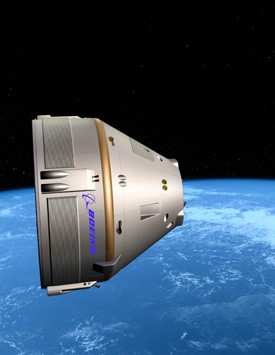Tue, Apr 24, 2012
Initial Commercial Space Transportation Flight Ops To Be Coordinated With Johnson Space Center
An agreement has been signed between NASA's Mission Operations Directorate (MOD) at Johnson Space Center and Boeing to collaborate on mission planning, training and flight operations for the company’s Commercial Space Transportation (CST)-100 spacecraft. Under the new arrangement, which Boeing negotiated under its current Phase 2 NASA Space Act Agreement for Commercial Crew Development, Boeing will begin discussions with the MOD on integrating launch operations and the company's own mission control facility at Kennedy Space Center, FL, with training and real-time operations at Johnson Space Center in Houston.

"Adding MOD to our team leverages NASA's experience in crewed space operations to ensure mission success for our CST-100 spacecraft," said Chris Ferguson, director of Crew and Mission Operations for the Boeing Commercial Crew Program. "As we continue to mature our spacecraft design, MOD technical support will ensure the CST-100 is built with the operators in mind."
Later this year, Boeing intends to enter into a larger agreement with the MOD to provide end-to-end flight operations from the command and control facility in the Mission Control Center at Johnson Space Center, the site where NASA managed the Apollo missions and all 135 flights of the space shuttle. "Colocating initial CST-100 flight operations with the International Space Station flight control facility in the Mission Control Center will facilitate a seamless transition to regularly scheduled CST-100 operations with the space station," Ferguson said. "Working with MOD on Boeing's mission operations also will help NASA retain key proficiencies for future human spaceflight operations."
The CST-100 is a reusable capsule-shaped spacecraft based on flight-proven subsystems and mature technologies. The system can transport up to seven people, or a combination of people and cargo. Boeing has designed the spacecraft to be compatible with a variety of expendable rockets to enable competition and reduce cost over the program life cycle. The company has selected United Launch Alliance's Atlas V launch vehicle for initial test flights that will begin as early as 2015.
Boeing is continuing to develop the system design at its Houston and Huntington Beach, Calif., sites and is making preparations to manufacture, assemble and test the CST-100 spacecraft in the former Orbiter Processing Facility-3 at Kennedy Space Center. (Image provided by Boeing)
More News
Airbus Racer Demonstrator Makes Inaugural Flight Airbus Helicopters' ambitious Racer demonstrator has achieved its inaugural flight as part of the Clean Sky 2 initiative, a corners>[...]
A little Bit Quieter, Said Testers, But in the End it's Still a DA40 Diamond Aircraft recently completed a little pilot project with Lufthansa Aviation Training, putting a pair of >[...]
Line Up And Wait (LUAW) Used by ATC to inform a pilot to taxi onto the departure runway to line up and wait. It is not authorization for takeoff. It is used when takeoff clearance >[...]
Contributing To The Accident Was The Pilot’s Use Of Methamphetamine... Analysis: The pilot departed on a local flight to perform low-altitude maneuvers in a nearby desert val>[...]
From 2015 (YouTube Version): Overcoming Obstacles To Achieve Their Dreams… At EAA AirVenture 2015, FedEx arrived with one of their Airbus freight-hauling aircraft and placed>[...]
 Airbus Racer Helicopter Demonstrator First Flight Part of Clean Sky 2 Initiative
Airbus Racer Helicopter Demonstrator First Flight Part of Clean Sky 2 Initiative Diamond's Electric DA40 Finds Fans at Dübendorf
Diamond's Electric DA40 Finds Fans at Dübendorf ANN's Daily Aero-Term (04.23.24): Line Up And Wait (LUAW)
ANN's Daily Aero-Term (04.23.24): Line Up And Wait (LUAW) NTSB Final Report: Extra Flugzeugbau GMBH EA300/L
NTSB Final Report: Extra Flugzeugbau GMBH EA300/L Classic Aero-TV: 'Never Give Up' - Advice From Two of FedEx's Female Captains
Classic Aero-TV: 'Never Give Up' - Advice From Two of FedEx's Female Captains



